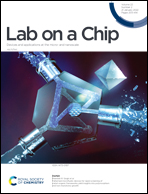Generation of droplets with adjustable chemical concentrations based on fixed potential induced-charge electro-osmosis†
Abstract
The effective control of the sample concentration within droplets is essential in a broad range of assays in chemistry and biochemistry. Here we provide an electrical method for producing batches of aqueous droplets with various chemical concentrations by exploiting fixed-potential induced-charge electroosmosis (ICEO) flow around a bipolar electrode. By applying an AC electric signal to the bipolar electrode and changing the zeta potential on it, the bipolar electrode acts as a gate electrode for generating asymmetric ICEO flow. The ICEO flow induced transverse vortexes interact with two parallel laminar streams with different chemical compositions. Controlled mixing of the aqueous solutions can be achieved by adjusting the shape and size of the asymmetric vortexes via altering the electric signal applied to the gate electrode. The mixed streams are split at a bifurcation, and one of the streams with a desired controlled concentration is pumped into a flow-focusing geometry to generate droplets with adjustable chemical concentrations. The in-droplet concentration increases in the range of 0.412–1.404 mM, as the applied voltage increases in the range of 0–70 mV at 15 kHz. This approach offers a promising method for on-chip control of chemical concentrations within droplets without labor-intensive dilutions while minimizing the sample consumption, showing great potential for next generation droplet-based applications.



 Please wait while we load your content...
Please wait while we load your content...